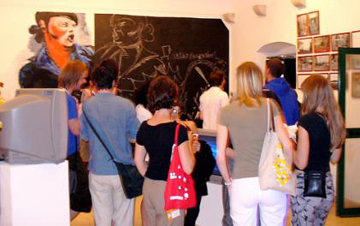June 19, 2007
Of money, meaning and artists in residence

Some commonistas confronted with the exhibition in residence, CC BY 2.0
Shortly before most of my fellow aesthetically challenged comrades arrived in Dubrovnik, whilst the keener iCommoners soaked up the Adriatic sun, a handful of artists in residence were toiling away to produce and curate an exhibition for our benefit. The low level of engagement from practising artists in fields beyond electronica music, academic writing and journalism is a problem familiar to any meeting of free culture communities. So it was a wonderful surprise to sit through a discussion between the artists in residence nominally set-up to discuss their engagment with the 'copyfight' and strategies to build sustainability for peer produced free culture, Less surprising was the theme of the presentations and subsequent conversations; their interest in, and engagement with, the 'commons-based peer production' ideology was varied and complex.
Nathaniel Stern, having been involved last year in Rio, has been trying to build upon that experience to explore how certain 'commons' values might be expressed through participatory sculpture that creates performances. He found a tension between those curated participants who held his frames and members of the public (largely kids) who interacted with the created space, and watching the spontaneity of this interaction certainly made physical and concrete some aspects of peer based production. Quite an irony, trying to replicate a form of production that is itself an abstraction from the concrete production he was engaging in! Or at least that is my interpretation of his work anyway. Nathanel - feel free to comment to the effect that this is a load of tosh!
One comment stood out for me. Joy Garnett, speaking about her experience with the (infamous?) Joywar episode, radically reconceptualised the copyfight. It's not about money, she suggested, it's a battle over meaning. The photojournalist who wanted to obstruct her work was insisting that the meaning of her photograph was intimitely connected to its context - the revolutionary struggle in Nicuragua - and so Joy's painting decontextualised the photo, stripping it of its meaning and artistic integrity. For Joy, the meaning of the work is inherently contextual, i.e. it will depend upon where it is exhibited, how it is exhibited, how it is reinterpreted and transformed by the audience or fellow artist. To constrain art by refusing others the right to recontextualise particular works is completely antithetical to her approach, and arguably to the history of both fine art and culture broadly defined.
In other words, the fight that exploded around that painting wasn't about one copyright owner trying to defend a particular financial interest, nor about a straightforward desire to control her work. It was a battle of critical theory and of aesthetics. Joy became interested in copyright because a key motivation of her work is transgression, and 'permission culture' copyright is one barrier that she finds herself transgressing in a desire to bring forgotten images to the public eye in new forms. She'd face the same barrier if she came across a Creative Commons licensed work that required permission to be sought for commercial use.
This sense that Joy's motivations and approach towards copyright was quite different to the standard Creative Commons discourse ran throughout each presentation. Nathaniel summed it up quite neatly when responding to a question about commercialising Creative Commonc licenses: it's not about using CC licenses to make money, it's about how those licenses relate to and facilitate different artistic practices; where they offer, or assist, a means of making money then so much the better. Ana Husman was refreshingly willing to recognise the public value of her work, and her civic responsibility to share her work freely when she received public funding. Kathryn Smith and Jaka eleznikar recognised that the general ethic of the commons was a natural fit with much of their work. There's a connection, certainly, but CC could hardly be put forward as a central part of their practise.
Too often we can start to view culture (and what a broad term that is!) through the lens of copyright, Creative Commons or even the free software community's norms. When we do this we lose sight of the intense diversity of artistic practice out there, and forget the true import and relevance of our work, so it was really significant to have a space where practising full time artists could discuss their thoughts with their fellow commonistas. [posted by tchance on iCommons iSummit]
Posted by jo at June 19, 2007 12:28 PM
